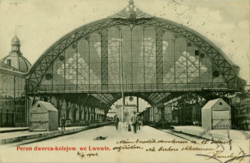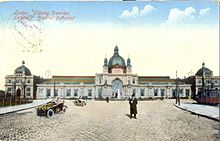[UA]
Головни́й залізни́чний вокза́л (також Льві́в-Головни́й, на львівській ґварі «Двірець») — вокзал станції Львів. Головний вокзал Львова та Львівської залізниці. Історично, це перший вокзал на території сучасної України.
З 1861 року, часу відкриття, це вже друга вокзальна споруда, зведена у 1904 році.
У 1841 році уряд Австрійської імперії затвердив Програму у справах залізниць, якою, серед іншого, було передбачено будівництво залізниць у Королівстві Галичини та Волині. Лінія з Відня доЛьвова мала бути збудована до 31 грудня 1863 року. Після цього місто мало бути сполучене з Бродами, Чернівцями та іншими містами коронної землі[2].
У 1858 році цісарсько-королівське Привілейоване товариство Галицьких залізниць імені Карла Людвіга отримало концесію на будівництво вокзалу у Львові. Будівництво велося на заболоченому узгір'ї на площі 67 моргів. Відкриття вокзалу відбулося одночасно з відкриттям руху Галицькою залізницею імені Карла Людвіга на ділянці Перемишль — Львів, 4 листопада 1861 року. О 14:30 прибув перший потяг у складі паротягу «Ярослав», двох пасажирських вагонів та чотирьох платформ. 24 листопада дирекція залізниці отримала дозвіл на регулярний рух потягів зі Львова доВідня і Кракова.
У 1866 році відкрито рух до Чернівців, у 1869 році — до Бродів і кордону з Російською імперією, у 1881 році — до Тернополя і Підволочиська.
У 1892 році залізниця стала власністю держави. Це пришвидшило притік інвестицій, відповідно, і будівництво нових ліній. Постало питання про будівництво у Львові нового залізничного вокзалу, адже існуючий не справлявся із зростаючим пасажиропотоком. У 1899 році було розглянуто і затверджено проект авторства Владислава Садловського, виконаний у 1898 році на підставі матеріалів директора залізниці Людвіка Вежбицького.

Дебаркадер вокзалу (
1904)
Будівництво розпочато у 1902 році на місці старого вокзалу. Будівельні роботи виконувала фірма Івана Левинського, Альфреда Захаревича та Юзефа Сосновського. Головний вхід та дебаркадер виконані за проектом інженера Є. Зеленевського. Інтер'єри залів очікування 1 і 2 класів спроектував А. Захаревич, інтер'єри залів очікування 3 класу, ресторану та їдальні спроетували Т. Обмінський та О. Лушпинський. Фронтон будівлі прикрасили скульптурами А. Попеля і П. Війтовича: жінка символізує залізницю і торгівлю, чоловік на леві — промисловість і місто Львів. Основним елементом оформлення головного вестибюля був вітраж «Архангел Михаїл» з панорамним видом Львова на тлі.
Вокзал відкрито 26 березня 1904 року.
20 червня 1915 року вокзал підпалили відступаючі війська Російської імперії. Споруда також значно постраждала під час польсько-української війни 1918—1919 років. В результаті були знищені початкові інтер'єри та центральний портал вокзалу[3]. Після переходу Львова до Польщі почалися роботи з відновлення вокзалу під керівництвом архітектора Генрика Заремби. У 1923 році на фасаді та всередині споруди встановлено кілька композицій Петра Війтовича. Повністю, перебудова львівського вокзалу завершилася лише у 1930 році.
Вокзал сильно постраждав під час Другої світової війни, яким він піддавався вже з першого дня війни — 1 вересня 1939 року. Повне повоєнне відновлення завершилося лише у 1957 році.
[EN]
Lviv Railway station is the main railway terminal in Lviv, Ukraine. It is one of the most notable pieces of Art Nouveau architecture in former Galicia. The station was opened to the public in 1904, and celebrated its centennial anniversary on 26 March 2004. On a monthly basis, the terminal handles over 1.2 million passengers and moves 16 thousand tons of freight.

Postcard of the station, circa 1915.
Construction of an extensive net of railways within the Austro-Hungarian Empire allowed the city of Lemberg (its German name at the time) to retain its nodal position at the crossing of several notable trade routes. As the capital of Galicia, the city needed a new, representative and large railway station that would suit the city needs and replace the old neo-Gothic railway station built between 1861 and 1862.
In 1888 the Polish architect and a graduate of the Lwów Technical Academy Władysław Sadłowski was selected to design a new station. The final project, prepared in less than a year, encompassed a large, horizontally-oriented main hall, with two large train yards located in the background. The main entrance was topped with a large dome made of bolted steel and stained glass. Both wings of the symmetrical building were constituted by two pavilions, each with a smaller cupola.
The main entrance was flanked by a set of Tuscan columns and large mythological sculptures, with the one representing Hypnos being the most notable. Since Sadłowski was the main representative of the William Morris' Arts and Crafts movement in Poland, his project included not only the architectural part of the future building, but also the ornaments and decorations. The project of three waiting halls (one for each class of travellers) was prepared in cooperation with another graduate of Sadłowski's alma mater, Alfred Zachariewicz.
The first class waiting hall was modelled after the style of an English gentleman's club, and was equipped with dark, luxurious Viennese-style furniture, resembling the works of the Wiener Werkstätte. The second class waiting room was modelled after 19th century burgher houses in Galicia, while the third class waiting hall was equipped with simple wooden pieces of furniture, modelled after the Zakopanestyle of Polish Gorals made by the artist Tadeusz Obmiński.
The ornaments featured in the tunnels leading to the platforms and in the platforms themselves were prepared by the Kraków-based company of Józef Górecki. Made of bent steel, the balustrades and railings bore direct resemblance to the style of the Paris Métro ornaments designed by Hector Guimard. A design for the registers was constructed in Zieleniewski Maschinen und Wagonbau-Gesellschaft Werk Sanok, (Autosan).
Construction started in 1899 and lasted until 1904, when the railway station was opened to the public. It was visited by some of the most renowned architects of the epoch, and influenced the later construction of the train stations in Prague (Josef Franta, 1909) and Vienna (Otto Wagner).
During World War II, when the city was under the rule of the Soviet Union, the Western Ukrainian railways were integrated into the Soviet Railway system. The station suffered extensive damage during the war, including a completely destroyed trainshed. There was an open debate on whether to restore the building or to dismantle the ruins and build anew. Architect G.F. Domashenko managed to bring both parties to agreement, and between 1949 and 1953 the old structure was given a contemporary Stalinist interior, whilst a full repair on the outside preserved its original view. Frequent renovations and upgrades ensured that the service and building was always up to modern standards, a tradition which Ukraine continued through the 1990s and into the 21st century, with the most recent major restoration being carried out in 2003.
